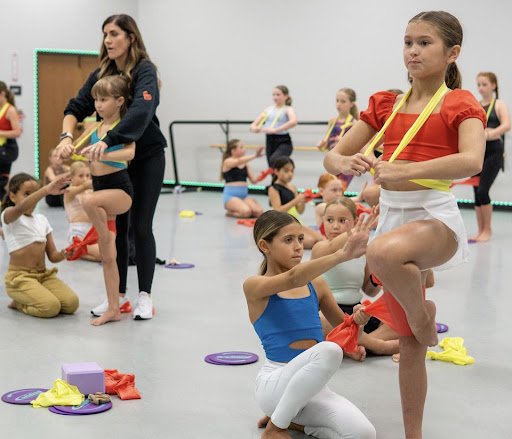Behind the Curtain: Exploring the Inner World of Dance
Alivia Rogers, Freshman Writer
Looking into the secrets behind the leotards, jazz shoes, and costumes reveals a world beyond imagination. Let us dive into the lives of current and past dancers from studios across the country. Prepare to be captivated by the mysteries that lie behind the curtain. What will it take to get to the top? How far is too far?
Being a dancer is a challenging task, especially one that competes. The average competitive dancer takes one ballet class, four technique classes, and one extended class to learn their competition dance. “When I was little, I did ballet and tap. When you are young, that's what most three-year-olds do. I then added jazz a few years later. I added pointe, hip-hop, jazz, lyrical, and contemporary technique classes when I got even older. I worked two hours per day, ten hours a week,” exclaims former dancer, Elliott Newman (‘27) The life of a competitive dancer entails countless hours in the studio.
Technique classes are crucial for a dancer. When competing, dancers are judged by five crucial categories: technique, performance, presentation, choreography, and overall impression. When judges are watching a dancer, these categories all fall into play, especially technique. Anna Worten, a dancer at Kim Massay Dance Productions, explains, “We dance four hours and thirty minutes each night. We do one hour and thirty minutes of block, thirty minutes of ballroom, thirty minutes of ballet, and 2 hours of technique.” Anna explains, “We do work pretty hard every day, but it’s all worth it because after all of the practice, we go out and win.” Dancers must always stretch, which explains why they work on stretching and the ability to pick up choreography quickly during technique classes.
Instructors expect dancers to pick up choreography from anyone, not just their regular teachers. Dancers learn this skill by participating in dance conventions, hiring outside choreographers, and attending auditions. In the photo below, Kim Massay dancers, including Anna Worten, are taking a technique class from an outside choreographer, Robert Contreras. Contreras trains the dancers to balance, have straight legs, and maintain an overall high technique in their pursuit of dance.
Dance conventions are technique building, two to three day courses that help dancers grow in all genres. Conventions usually span six to seven hours a day for two to three days. Each class is one hour, and every style of dance is taught. Conventions also include an audition for a scholarship to either the dance convention or different dance schools. “Dance conventions are so much fun! We get to learn a bunch of new combos, and audition for cool things. The audition helps and prepares us for more auditions in the future,” Anna explains.
It was May 21, 2022. At last, the day all of the dancers had been training for. After waking up at 6 am, Anna quickly pulled her hair into a slick, low bun, with pounds of gel and hairspray. She threw on tons of concealer, foundation, and blush, with a smoky eye to finish the look. There was no time, so she hopped in the car, grabbed her bright red lipstick, and painted it on her lips. Once she finished with the lip liner, she threw on her earrings. She arrived at the competition. At last, the moment Anna had been preparing for; competition time. Competition is the most important part of a dancer's dance season: the culmination of heartache, pain, and hours in the studio.
Meanwhile, past dancer Elliot Newman(27) had her own competition to win. “I was scared because we had a dance of five girls, but three dropped out. Now there was only me and another girl. I was stressed out because I have never done a duet before.” Elliot arrived at the competition as a nervous wreck. She never knew what competing in a duet was like. Duets are difficult; the timing has to be perfect. If you forget the dance, you can’t just make it up, because there is another person dancing with you. When she arrived, she applied makeup and threw on her costume.
The yelling and screaming in the dressing room overwhelmed Anna. Anna and her team walked backstage and got in formation. Then, all went quiet, “Next on the stage is act number 423: ‘Rain,’” the announcer said over the speaker. It was silent again. Anna had been preparing for this moment all season. She took one step on stage, and the audience roared in claps and cheers. The music began to play.
When Anna went out on the stage, she remembered why she is a dancer. Elliot realized that dance was all worth it in the end. Anna looked the judges straight in the eyes. When Elliot walked off that stage, she knew they had crushed it. They were both aiming for that top spot. After all the hours in the studio and bleeding feet, all the audience saw was what was in front of the curtain.



